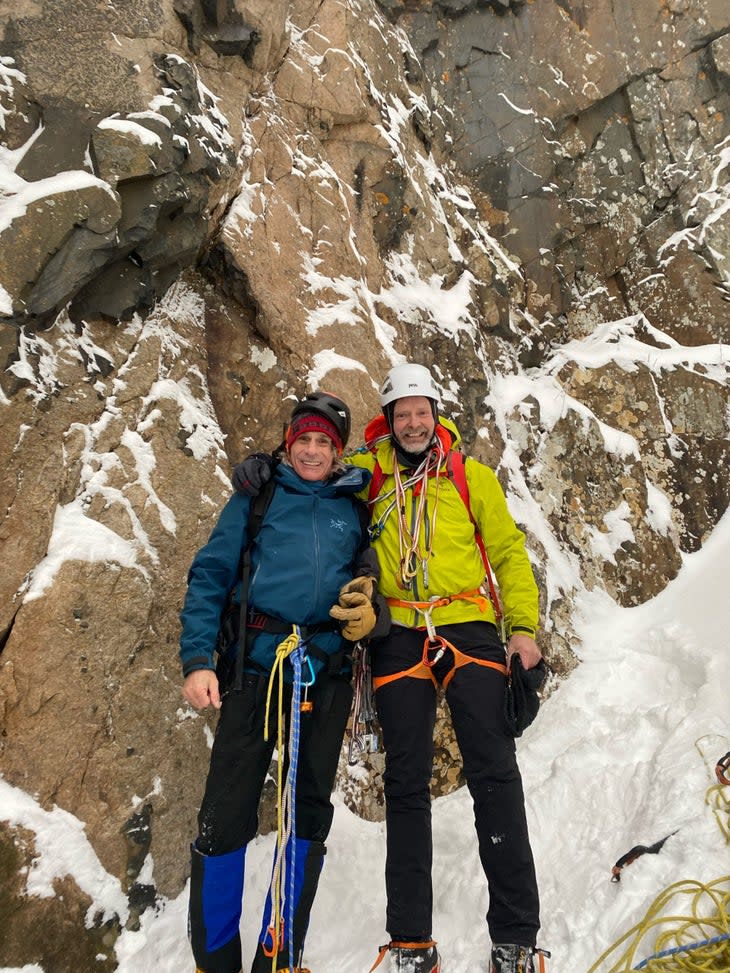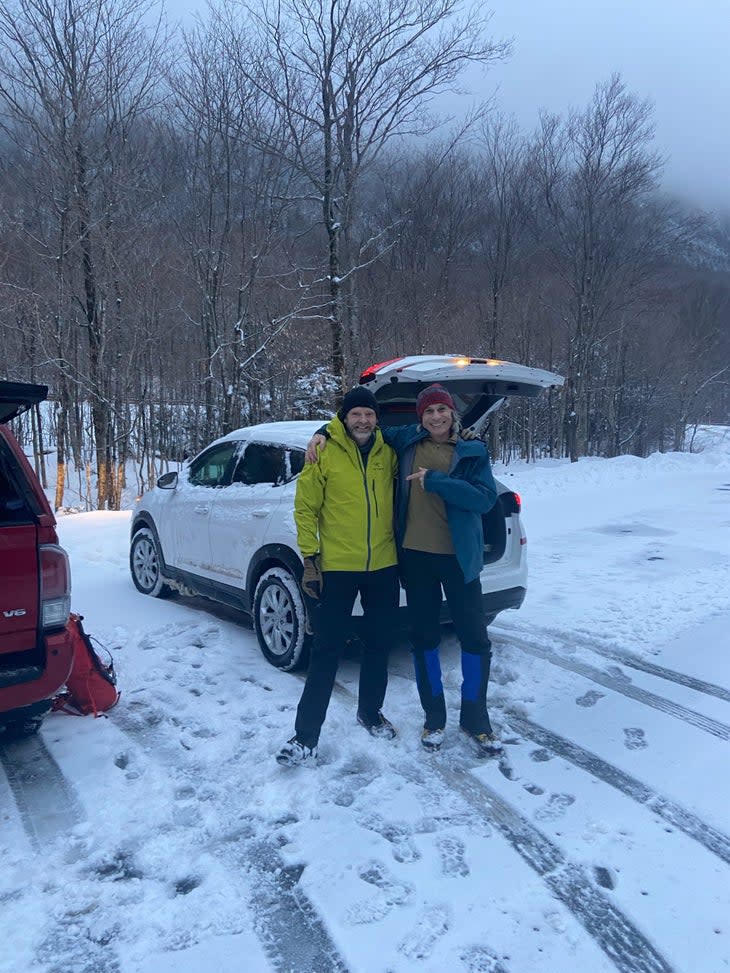50 Years After Barely Surviving the FA, John Bouchard Returns to the Black Dike
On December 18, 1971, a 19-year-old kid named John Bouchard booted up 1,000 feet of snowy talus, took a deep breath, and then entered New Hampshire legend by soloing the first ascent of the Black Dike--a 600-foot cleft on Cannon Cliff, in Franconia Notch, New Hampshire.
On December 19, 2021, 50 years and one day after the first ascent, Bouchard, now 69, returned to the Dike with Nick Yardley (another New England legend) and ran a quick morning lap.

Today, the Black Dike (WI4, M3) is widely considered one of New England's best alpine climbs. It's a trade route, three-pitches, very popular, offering a blend of moderate ice and mixed climbing depending on conditions. But when Bouchard first climbed it in 1971, his ascent was a big deal.
A year earlier, Yvon Chouinard, at the time America's leading authority on ice climbing, called the Black Dike a "black, filthy, horrendous icicle," then added that it was also "the last great problem" on the East coast. His remarks effectively marked the Dike as New Hampshire's most sought-after alpine objective. Climbers from Dartmouth, Harvard, and just about every other elite mountaineering club in the Northeast were desperate to try it, as were local climbers and guides. And Bouchard, by climbing it first, instantly transformed himself from a no-name kid to one of America's most promising alpinists.

But the climb almost killed him. Bouchard intended to attempt the Dike with a partner, but his partner bailed, so he decided, as 19-year-olds sometimes do, to forge ahead and rope solo the route. Things got spicy on the second pitch when his lead line froze to the ice and wouldn't budge. Desperate, Bouchard cut himself loose and climbed on, retreat no longer an option. He lost three mittens (having brought two pair of Dachstein mittens and one pair of fingerless gloves called Millarmits) and broke the pick off his alpine hammer. He pressed on into unknown terrain with just his 70-centimeter ice axe--the kind primarily used by mountaineers on snow slopes today. A storm rolled in, nineteen degrees and snowing, and he was pummeled with wind and spindrift. "Every move was the hardest move I'd ever made in my life," he told me on the phone. "[Every move] I thought I was going to fall off."
When he finally topped out into the scrubby birches above the cliff, he'd had what he now admits was a "transformative" experience.
He paused after telling me this. Then added:
"What a cliche."
But Bouchard's ascent of the Black Dike was exactly that: It was transformative, for him and for North American ice and alpine climbing.
In his piece "The Wild Ones", published in the January 2020 issue of Rock and Ice, Michael Wejchert credited Bouchard with igniting the ice climbing revolution of the 1970s, which saw New England climbers like Henry Barber, Rick Wilcox, and John Bragg pushing the envelope across the U.S. and in places like Norway and Patagonia.
He also credited Bouchard's ascent--the sheer rash craziness of it--with building a lasting mystique around the Black Dike itself, a sense of lore that has enlarged the route in the minds of subsequent ascensionists. Wejchert again: "When I first climbed the route a decade ago, also alone, too young to know better, and hemmed in by darkness, the thought of doing so with Chouinard's old hardware spooked me as much as the yawning, yellow void I'd tumble down if I fell. With modern gear, the climb is easy--the crux is getting to the base before half of Boston does--and most of the Black Dike's allure lies not in the climbing itself but in reimagining a young kid venturing into the unknown at a time when Nixon was still in office, and winter climbing was being made up as everyone went along."
The climb launched Bouchard's climbing career. He went on to do (among other things) the first ascent of the South Face Direct of Chacraraju (20,039 feet), in Peru; the first ascent of the North Couloir on the north face of the Grand Charmoz (11,302 feet), in Chamonix, France; the first solo ascent of Mt Blanc's Grand Pilier d'Angle, via a new route; and, with fellow New Englander Mark Richey, the second ascent (and first in alpine style) of Mt. Shivling (21,467 feet) in India. As an outdoor entrepreneur, he founded Wild Thing, a gear company, and Feral, the first company to design and sell paragliding wings in the United States. (He's considered the father of North American paragliding and was for years the leading paraglider in the country.)
Then, in the late 1990s, Bouchard met his wife, Nancy Prichard, a former editor at Rock and Ice, and pivoted. They relocated to Bend, Oregon, to start a family, and Bouchard earned a doctorate in education, spending the next twenty years improving high school graduation rates among at-risk youths in Central Oregon. He was named the GED Educator of the Year by the state of Oregon in 2019.
Bouchard kept climbing of course, five days a week, mainly at Smith Rock and in the gym. ("We've really turned into gym rats," his wife Nancy admitted on the phone). But he no longer went on expeditions, and he no longer climbed ice.

Indeed, when we talked, Bouchard wasn't sure when he'd last swung an ice axe. Was it at the X Games... or, was it, yes, it was back in 1999, when he took the writer Andrew Todhunter up, you guessed it, The Black Dike.
On that climb, Bouchard actually took a fall after breaking a hold off the mixed section at the beginning of the second pitch--an experience Todhunter recalls in his essay "On Cannon Cliff," published in The Atlantic in November 1999. Bouchard was uninjured by the fall, though he was a little surprised.
I asked Bouchard whether it was a little haunting to fall on a route he'd once soloed.
Bouchard laughed.
"I've thought a lot about that," he said, then told me about the summer of 1976, which he spent climbing at Cathedral Ledge and Whitehorse in North Conway, New Hampshire. One of the first routes he did there was Recompense, an ultra-classic three-pitch 5.9 that he first tried on a rope, with a partner. Good thing, too, since he fell off the laybacks on the third pitch. "I soloed it the next week," he added. "So, yeah, I've fallen off stuff I've soloed... The thing is just don't fall... Or be lucky."
He laughed again.
"That first comment is the old John: Don't fall. The second comment is the mature John: Be lucky."
He got very lucky on the first ascent of the Black Dike, he said. And he got very lucky ten years later, also at the Dike, when the whole first pitch collapsed on him, avalanching him and a friend down 1,000 feet of talus and breaking several of his ribs.
But he was perhaps most lucky at Whitehorse, years later, when a paraglider he'd built (he tested each wing before selling it) malfunctioned. He was blown back into the cliff, breaking an arm and two vertebrae, but managed to catch himself on a ledge a few hundred feet above the ground. He held desperately to the cliff, too injured to haul the paraglider's wing in, while the buffeting fabric threatened to tug him off the wall. Luckily, Nick Yardley--the very same friend with whom he made the 50th anniversary ascent of the Dike--happened to be climbing Whitehorse slab when the accident happened. He reached Bouchard before the wing tugged him to his death.

So what was the climb like, fifty years later?
It was cold. According to Yardley, Bouchard was kindly reacquainted with the screaming barfies. Bouchard, meanwhile, was amazed by the quality of modern gear. "The tools, you don't even need to swing 'em, you just hook 'em. And the ice screws: they turn right in! The stuff is amazing."
Nancy Prichard Bouchard was somewhat more forthcoming, emotionally.
"I think there's a certain point in life when even if you're always moving ahead, which John always is, there's a joy in looking back over the whole continuum of where you were and where you are now," she said. "It just made him so happy."


